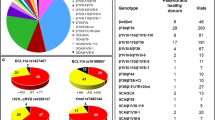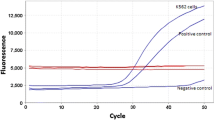Abstract
Due to genetic heterogeneity of β-thalassemia (β-thal) patients, several efforts have been undertaken to determine the efficacy of hydroxyurea treatment. The aim of this work is to determine the responder and nonresponder for hydroxyurea treatment in β-thal intermedia based on γ-globin mRNA and fetal hemoglobin (HbF) induction in human erythroid progenitor cells purified from a patient’s peripheral blood. Eighteen β-thal/hemoglobin E patients [13 βE/codon41/42(-TCTT), 4 βE/codon17, and 1 βE/IVS-654], requiring blood transfusion occasionally, with Hb levels of 5.20–8.50 g/dl were studied. The relative levels of γ-globin mRNA was measured by real-time reverse-transcription polymerase chain reaction and HbF by high-performance liquid chromatography. The results indicated that erythroid progenitor cells treated with 30 μmol/l hydroxyurea for 96 h preferentially enhanced Gγ-and Aγ-globin mRNA. The mean values of Gγ-globin mRNA fold induction were higher than Aγ-globin mRNA (12±4 vs 4±0.30), the Pearson’s correlation of Gγ-and Aγ-globin mRNA was r=0.80. Induction of Gγ/Aγ globin mRNA is up to ninefold. A 30% increase in the proportion of HbF out of the total Hb was found in cultures derived from four patients, 20–30% in cultures from nine patients, and less than 20% in cultures from five patients. In cultures from only two patients, increase in the proportion of HbF was less than 3%, and Gγ/Aγ globin mRNA is less than 0.50.
Similar content being viewed by others
References
Higgs DR, Thein SL, Woods WG (2001) The physiology of the thalassemia. In: Weatherall DJ, Clegg B (eds) The Thalassemia Syndromes, 4th ed. Blackwell Science Ltd, Oxford, pp 265–284
Weatherall DJ (2001) The thalassemias. In: Stamatoyannopoulos G, Majerus PW, Perimutter RM, Varmus.H (eds) The molecular basis for blood disorders, WB Saunders, Philadelphia PA, pp 183–226
Charache S, Terrin ML, Moore RD et al (1995) Effect of hydroxyurea on the frequency of painful crises in sickle cell anemia. N Engl J Med 332:1317–1322
Fucharoen S, Siritanaratakul N, Winichagoon P, Chowthaworn J, Siriboon W, Muangsup W, Chaicharoen S, Poolsup N, Chindavijak B, Pootrakul P, Piankijagum A, Schechter AN, Rodgers GP (1996) Hydroxyurea increases hemoglobin F levels and improves the effectiveness of erythropoiesis in beta-thalassemia/hemoglobin E diseases. Blood 87:887–892
Fucharoen S, Winichagoon P, Wisedpanichkij R, Sae-Ngow B, Sripanich R, Oncoung W, Muangsapaya W, Chowthaworn J, Kanokpongsakdi S, Bunyaratvej A, Piankijagum A, Dewaele C (1998) Prenatal diagnoses of thalassemias and hemoglobinopathies by HPLC. Clin Chem 44:740–748
Maier-Redeiersperger M, De Montalembert M, Flahault A et al (1998) Fetal hemoglobin and F-cell responses to long-term hydroxyurea treatment in young sickle cell patients. Blood 91:4472–4479
Rodgers GP, Sauntharajah Y (2001) Advances in experimental treatment of beta thalassemia. Exp Opin Invest Drugs 10:925–934
Fibach E, Burke LP, Schechter AN, Nogusi CT, Rodgers GP (1993) Hydroxyurea increases fetal hemoglobin in cultured erythroid cellsderived from normal individuals and patients with sickle cell anemia. Blood 81:1630–1635
Aker M, Dover G, Schrier S, Rachmilewitz EA (1995) Combination of erythropoietin and hydroxyurea results in improved quality and quantity of RBC in 7 patients with thalassemia intermedia. In: Beuzard Y, Lubin B, Rosa J (eds) Sickle cell disease and thalassemias: new trends in therapy, John Libbey Eurotext, London, pp 197
Huang S-Z, Ren Z-R, Chen M-J, Xu H-P, Zeng Y-T, Rodgers GP (1994) Treatment of β-thalassemia with hydroxyurea (HU)-Effects of HU on globin gene expression. Sci China B 37:1350–1359
Chang SS, Boehm CD, Higgs DR, Cutting GR (2000) Single -tube multiplex-PCR screen for common determinants of β-thalassemia. Blood 95:360–362
Winichagoon P, Saechan V, Sripanich R, Nopparatana C, Kanokpongsakdi S, Maggio A, Fucharoen S (1999) Prenatal diagnosis of β-thalassemia by reverse dot blot hybridizaion. Prenatal Diag 19:428–435
Choi I, Muta K, Wickrema A, Krantz SB, Nishimura J, Nawata H (2000) Interferon gamma delays apoptosis of mature erythroid progenitor cells in the absence of erythropoietin. Blood 95:3742–3749
Matsushima T, Nakashima M, Oshima K, Abe Y, Nishimura J, Nawata H, Watanabe T, Muta K (2001) Receptor binding cancer antigen expressed on SiSo cells, a novel regulator of apoptosis of erythroid progenitor cells. Blood 98:313–321
Sawada K, Krantz SB, Kans JS, Dessypris EN, Sawyer S, Glick AD, Civin CI (1987) Purification of human erythroid colony-forming units and demonstration of specific binding of erythropoietin. J Clin Invest 80:357–366
Muta K, Krantz SB (1993) Apoptosis of human erythroid colony-forming cells is decreased by stem cell factor and insulin like growth factor I as well as erythropoietin. J Cell Physiol 156:264–271
Sui X, Krantz SB, Zhao Z (1997) Identification of increased protein tyrosine phosphatase activity in polycythemia vera erythroid progenitor cells. Blood 90:651–657
Sui X, Krantz SB, Zhao Z (2000) Stem cell factor and erythropoietin inhibit apoptosis of human erythroid progenitor cells through different signalling pathways. Br J Haematol 110:63–70
Dover GJ, Boyer SH (1980) Quantitation of hemoglobins within individual red cells: asynchronous biosynthesis of fetal and adult hemoglobin during erythroid maturation in normal subjects. Blood 56:1082–1091
Wood WG, Jones RW (1981) Erythropoiesis and hemoglobin production: a unifying model involving sequential gene activation. In: Stamatoyannopoulos G, Nienhuis AW (eds) Hemoglobins and Development in Differentiation, Alan R Liss Inc, New York, pp 243–261
Papayannopoulou Th, Kalmantis T, Stamatoyannopoulos G (1979) Cellular regulation of hemoglobin switching: evidence for inverse relationship between fetal hemoglobin synthesis and degree of maturity of human erythroid cells. Proc Natl Acad Sci USA 76:6420–6424
Chomczynski P (1993)A reagent for the single-step simultaneous isolation of RNA, DNA and proteins from cell and tissue samples. Biotechniques 15:532–537
Watanapokasin Y, Winichagoon P, Fucharoen S, Wilairat P (2000) Relative quantitation of mRNA in β-thalassemia/HbE using real-time polymerase chain reaction. Hemoglobin 4:105–116
Winichagoon P, Fucharoen S, Wilairat P, Cihara K, Fukumaku Y (1995) Role of alternatively spliced beta E-globin mRNA on clinical severity of beta-thalassemia/hemoglobin E disease. Southeast Asian J Trop Med Public Health 26(S1):241–245
Winichagoon P., Fucharoen S, Chen P, Wasi P (2000) Genetic Factors Affecting Clinical Severity in Thalassemia Syndromes. J Pediatr Hematol Oncol 22:573–580
Fibach E, Manor D, Oppenheim A, Rachmilewitz EA (1989) Proliferation and maturation of human erythroid progenitors in liquid culture. Blood 73:100–103
Fibach E, Manor D, Treves A, Rachmilewitz EA (1991) Growth of normal erythroid progenitors in liquid culture: a comparison with colony growth in semisolid culture. Int J Cell Cloning 9:57–64
Hopp C, Vichinsky E, Lewis B, Foote D, Styles L (1999) Hydroxyurea and sodium phenylbutyrate therapy in thalassemia intermedia. Am J Hematol 62:221–227
Rodgers GP, Rachmilewitz EA (1995) Novel treatment options in the severe β-globin disorder. Br J Haematol 91:263–268
Atweh GF, Sutton M, Nassif I, Boonsaild V, Dover GJ, Wallenstein S, Wright E, McMahon L, Stamatoyannopoulos G, Faller DV, Perrine SP (1999) Sustained induction of fetal hemoglobin by pulse butyrate therapy in sickle cell disease. Blood 93:1790–1797
Rodgers GP, Rachmilewitz EA (1995) Novel treatment options in the severe β-globin disorder. Br J Haematol 91:263–268
Zeng YT, Huang SZ, Ren ZR, Lu ZH, Zeng FY, Schechter AN, Rodgers GP (1995) Hydroxyurea therapy in β-thalassemia intermedia: improvement in haematological parameters due enhanced β-globin synthesis. Br J Haematol 90:557–563
Janes SM, Cunningham JM (1998) Understanding fetal globin gene expression: a step towards effective HbF reactivation in haemoglobinopathies. Br J Hematol 102:415–422
Smith RD, Constance JL, Noguchi T, Schechter AN (2000) Quantitative PCR analysis of HbF inducers in primary human adult erythroid cells. Blood 95:863–869
Acknowledgement
This work was supported by The Thailand Research Fund.
Author information
Authors and Affiliations
Corresponding author
Rights and permissions
About this article
Cite this article
Watanapokasin, R., Sanmund, D., Winichagoon, P. et al. Hydroxyurea responses and fetal hemoglobin induction in β-thalassemia/HbE patients’ peripheral blood erythroid cell culture. Ann Hematol 85, 164–169 (2006). https://doi.org/10.1007/s00277-005-0049-1
Received:
Accepted:
Published:
Issue Date:
DOI: https://doi.org/10.1007/s00277-005-0049-1




